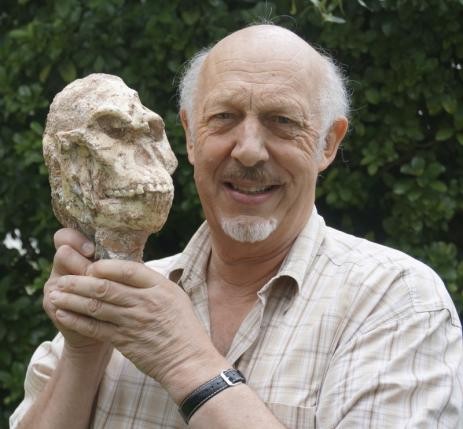Finally, Scientists Agree on Little Foot's Birthday
| Marco Foronda | | Apr 02, 2015 02:38 AM EDT |
(Photo : REUTERS/WITS UNIVERSITY/) Ron Clarke, a professor in the Evolutionary Studies Institute at Wits University in South Africa, holds the Little Foot skull.
The age of an ancient South African proto-human fossil called Little Foot has finally been agreed upon.
The Australopithecus specimen is now 3.67 million years old, a contemporary of world-famous Lucy, Ethiopia's fossilized female Australopithecus afarensis specimen.
The new findings suggest Little Foot was an older relative of "Lucy," the famous Australopithecus skeleton dated at 3.2 million years old and found in Ethiopia. Little Foot was first discovered about two decades ago in a South African cave and is believed to represent an Australopithecus Prometheus lineage.
Like Us on Facebook
"It demonstrates that the later hominids, for example, Australopithecus africanus and Paranthropus did not all have to have derived from Australopithecus afarensis", said Ronald Clarke, a professor in the Evolutionary Studies Institute at the University of the Witwatersrand, who discovered the skeleton.
"We have only a small number of sites and we tend to base our evolutionary scenarios on the few fossils we have from those sites. This new date is a reminder that there could well have been many species of Australopithecus extending over a much wider area of Africa,"
New analysis verifies the younger sediment formed within cavities left when portions of the old rock dissolved.
Researchers used a radioisotopic dating technique developed by Darryl Granger, a professor of earth, atmospheric and planetary sciences at Purdue. The technique, dubbed as isochron burial dating, measures levels of isotopes (specifically aluminum-26 and beryllium-10) found in rocks surrounding a fossil.
Afterwards, a graph of the isotope ratios called an isochron is then created for the rock samples to demonstrate if they have been compromised and are good candidates for dating.
The study appeared in a recent edition of the journal Nature.
TagsFinally, Scientists Agree on Little Foot's Birthday, evolution, Human evolution, Little Foot, human fossil, Fossil, Lucy, Australopithecus afarensis, South African cave, radioisotopic, isochron burial dating
©2015 Chinatopix All rights reserved. Do not reproduce without permission
EDITOR'S PICKS
-

Did the Trump administration just announce plans for a trade war with ‘hostile’ China and Russia?
-

US Senate passes Taiwan travel bill slammed by China
-

As Yan Sihong’s family grieves, here are other Chinese students who went missing abroad. Some have never been found
-

Beijing blasts Western critics who ‘smear China’ with the term sharp power
-

China Envoy Seeks to Defuse Tensions With U.S. as a Trade War Brews
-

Singapore's Deputy PM Provides Bitcoin Vote of Confidence Amid China's Blanket Bans
-

China warns investors over risks in overseas virtual currency trading
-

Chinese government most trustworthy: survey
-

Kashima Antlers On Course For Back-To-Back Titles
MOST POPULAR
LATEST NEWS
Zhou Yongkang: China's Former Security Chief Sentenced to Life in Prison

China's former Chief of the Ministry of Public Security, Zhou Yongkang, has been given a life sentence after he was found guilty of abusing his office, bribery and deliberately ... Full Article
TRENDING STORY

China Pork Prices Expected to Stabilize As The Supplies Recover

Elephone P9000 Smartphone is now on Sale on Amazon India

There's a Big Chance Cliffhangers Won't Still Be Resolved When Grey's Anatomy Season 13 Returns

Supreme Court Ruled on Samsung vs Apple Dispute for Patent Infringement

Microsoft Surface Pro 5 Rumors and Release Date: What is the Latest?










